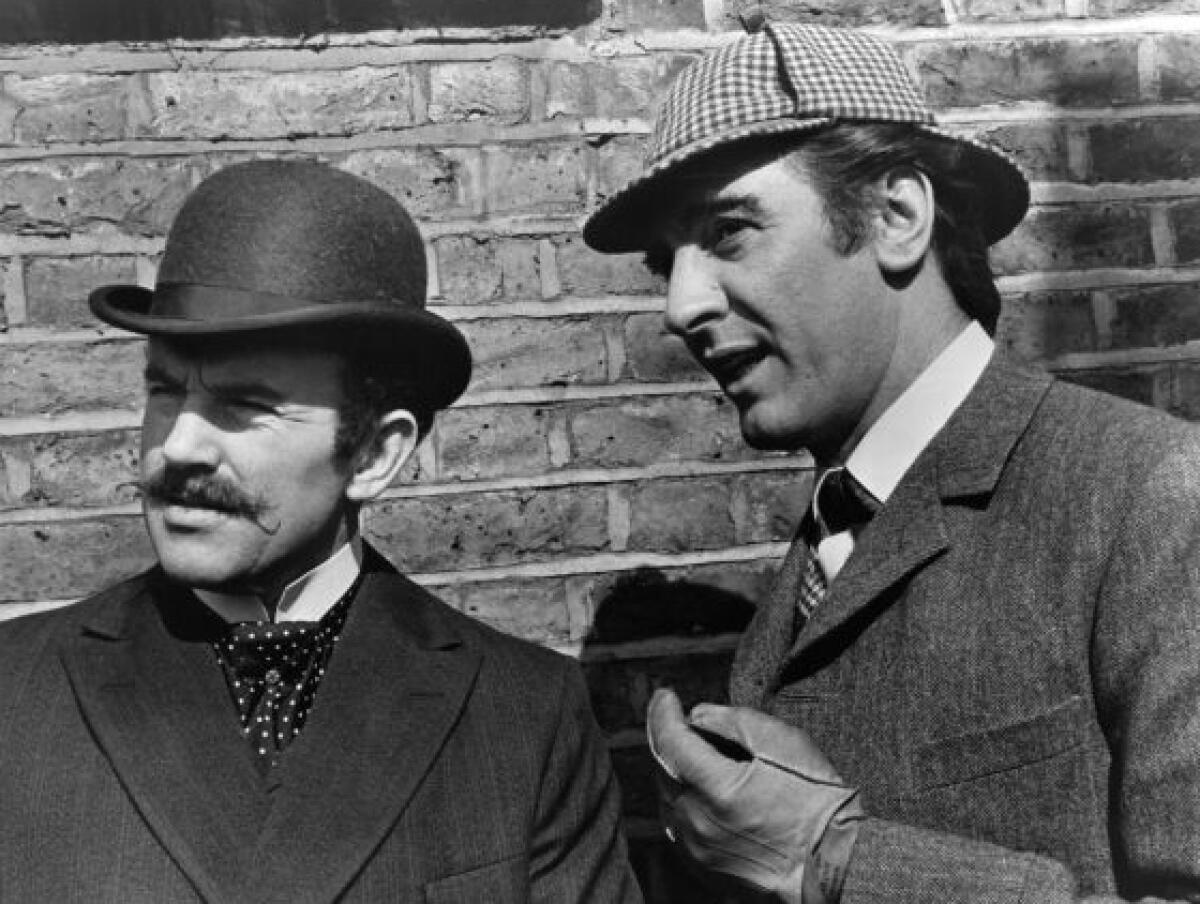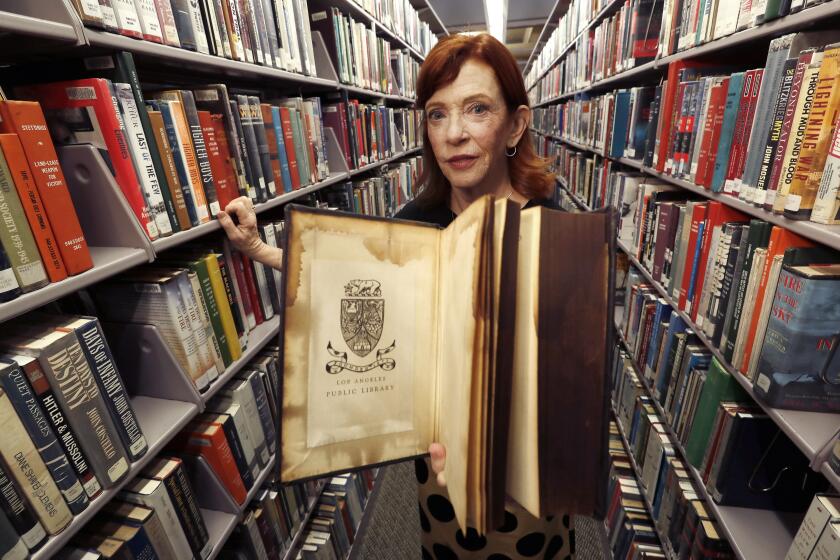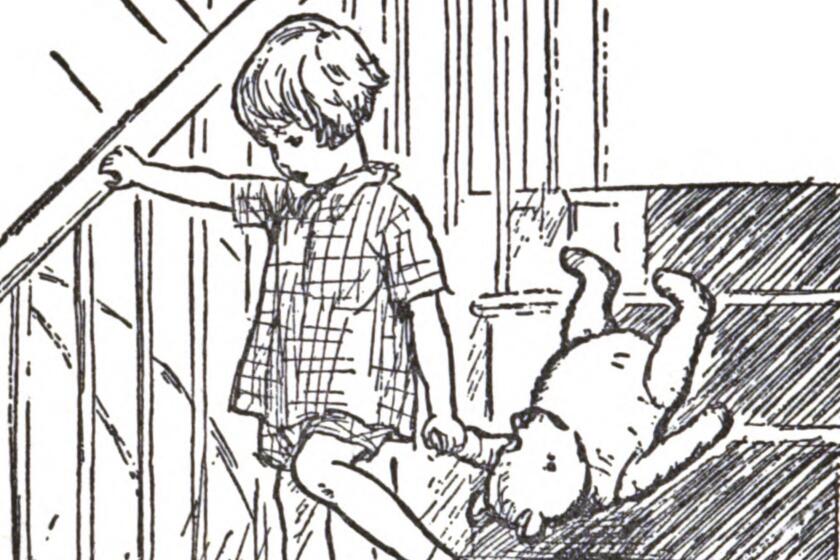Column: These historic works are coming free from copyright. Why did it take so long?

- Share via
It’s well understood that Sherlock Holmes dispatched his great nemesis, Professor Moriarty, to his death in the 1893 story “The Final Problem,” but not until this New Year’s Day does the fictional detective shed the shackles that have bound him to an even longer-lived nemesis: the complexities of copyright law.
On Sunday, the last of the Sherlock Holmes stories written by Arthur Conan Doyle enters the public domain. The expiration of the copyright on the last stories published by Conan Doyle, in the 1927 volume “The Case-Book of Sherlock Holmes,” writes the final chapter to a long-lasting battle over the publication rights to Holmes and Dr. Watson waged by the Conan Doyle estate.
“They’re out of copyright arguments,” says Jennifer Jenkins, director of the Center for the Study of the Public Domain at Duke University. Every year at about this time, Jenkins produces a list of creative works, classic and merely popular, that enter the public domain in the U.S. on New Year’s Day.
The general public’s interest in copyright legislation is diffuse; a grass-roots revolt of copyright users seems unlikely.
— Copyright expert Jessica Litman (1994)
This year’s roster covers works published in 1927 and therefore subject to final copyright expiration as of 2023.
As usual, it’s a treasure trove. Among the literary works are Virginia Woolf’s “To the Lighthouse,” Willa Cather’s “Death Comes for the Archbishop,” William Faulkner’s second novel, “Mosquitos” (his first, “Soldier’s Pay,” entered the public domain in 2022), and “The Tower Treasure,” the first Hardy Boys mystery by the pseudonymous Franklin W. Dixon.
Get the latest from Michael Hiltzik
Commentary on economics and more from a Pulitzer Prize winner.
You may occasionally receive promotional content from the Los Angeles Times.
Among the 1927 films entering the public domain are the silent classics “Metropolis,” “Wings” (the winner of the first best-picture Academy Award), “The Lodger” (Alfred Hitchcock’s first thriller) and “The Jazz Singer,” the Al Jolson talkie that effectively put silent films out of business. Also on the list is an early Laurel and Hardy classic, “The Battle of the Century,” featuring the pie fight that made pie fights a movie staple.
Musical compositions (sheet music and lyrics only) include “The Best Things in Life Are Free,” “I Scream, You Scream, We All Scream for Ice Cream,” Irving Berlin’s “Puttin’ on the Ritz” and Duke Ellington’s “Black and Tan Fantasy.”
With the expiration of their copyrights, these works become “free for all to copy, share, and build upon,” Jenkins says.
The dribbling of classic works into the public domain every year on Jan. 1 may be gratifying, but it also serves to underscore the stupidity and cupidity of our convoluted copyright system.
Calculating the duration of copyright protection can be a complicated process, depending not only on when works were created and published, but when their creators died, whether they formally registered for copyright and renewed it, and the format of the works.
Publishers and authors rightly fear that they’ll lose out financially from the digitization of books; but it’s also quite possible that, properly managed, the technological revolution will make them more money.
Musical compositions copyrighted in 1927 move into the public domain in 2023, but not recordings of the songs made later. Silent films from 1927 are coming out of copyright, but not necessarily title cards or accompanying music added later.
Frequent congressional changes in copyright rules and duration are mostly responsible for the confusion. The argument for extending copyright terms has always been that the extensions give creators or their heirs that much more time to collect income and therefore incentive to keep their creative juices flowing, and who could object to that?
As Jenkins and other copyright experts point out, however, only a minuscule fraction of published creative works generate income for more than a few short years.
The impetus for extending copyright duration comes almost entirely from corporate enterprises intent on squeezing the maximum income from creative franchises.
In 1998, Walt Disney Co. pushed for enactment of the Copyright Term Extension Act, the 1998 federal law known as the Sonny Bono Act after its chief promoter in Congress. The act set copyright duration at the author’s life plus 70 years, or 95 years after publication for works done for hire.
But it’s vanishingly unlikely that a posthumous 95-year term would be an incentive to any living artist or writer. It was, however, a bounty for Disney, which at the time was facing the expiration of rights to the earliest films featuring Mickey Mouse and the looming cutoff of the royalty spigot.
Thanks to the extension, the rights to the first Mickey Mouse cartoon, “Steamboat Willie,” won’t expire until Jan. 1, 2024 — assuming Congress doesn’t extend copyright duration again.
Whether the rules as they stand today serve the public interest is open to question. Consider the stringent control exercised by the estate of the Rev. Martin Luther King Jr. — mostly his children — over his speeches and writings such as the “I Have a Dream” speech he delivered at the Lincoln Memorial on Aug. 28, 1963.
‘Winnie-the-Pooh,’ ‘The Sun Also Rises’ and many other works entered the public domain on Saturday. They show what’s wrong with the system.
As copyright expert Arlen W. Langvardt traced the copyright status of the speech in 2015, on the day it was delivered, the speech was eligible for copyright protection through 2019 (a 28-year term plus a 28-year renewal if applied for by the owner). Congress subsequently extended the duration of copyright to the life of the creator plus 70 years.
But that was for works published in 1978 or later. For pre-1978 works, such as the speech, the old terms applied, except the renewal rights were extended by 19 years. Another congressional act afforded those works yet a further 20 years of protection.
The copyright on “I Have A Dream,” therefore, won’t expire until 2058, or nearly a century after King delivered it to a massive crowd at the Lincoln Memorial and untold more viewers on television. (Federal courts have ruled that the public delivery of the speech didn’t invalidate its rights to copyright, which King himself exercised.)
In the meantime, the King family has ridden herd on numerous usages of their forebear’s speeches and writings. As I’ve reported before, filmmaker Ava DuVernay put rewritten and paraphrased lines into the mouth of the actor portraying King in her film “Selma,” which depicted his role in the 1965 protests in support of the Voting Rights Act.
DuVernay didn’t use King’s actual words because the film rights had been sold to Steven Spielberg for a still-unproduced project. Moreover, she said, acquiring the rights from the King family would have involved giving them a voice in how King was portrayed, constraining her own artistic choices.
The murkiness of copyright law was a factor in the Conan Doyle estate’s long fight with creative artists wishing to put Holmes and Watson into new works. The estate maintained in lawsuits that it retained the rights to the characters as long as any of Conan Doyle’s novels or stories remained under copyright.
Thanks to the efforts of Leslie S. Klinger, a Westwood lawyer and leading authority on all things Sherlockian, that argument was thrown out of court. But the possibility of a successful infringement challenge remained a background threat.
“The Conan Doyle estate is trying to protect its money,” Klinger told me in 2014, after an important ruling against the estate. “They like to say this is about quality control, and they’ve kept some real crap off the market. But there’s so much crap out there that it’s a little late to be worrying about quality control.”
Anyway, now that the last Holmes stories written by Conan Doyle are losing their legal shield, the characters of Holmes and Watson will indisputably belong to the public.
In some cases, extending copyright protection works against the survival of creative works. That’s most evident in the case of silent films.
Once talkies came to dominate filmmaking, — starting in 1927 with “The Jazz Singer” (which will enter the public domain on Jan. 1) — Hollywood studios all but abandoned their silent film archives.
It’s a fair bet that Anne Frank never expected her diary to be published, though she may have wished it to be preserved.
“The studios — wrongly as it turns out — thought that silent films had no enduring commercial or cultural value,” Jenkins says. “Our silent film heritage, all these reels and canisters, were melted down and destroyed for their silver content, or thrown out or just left to decay, and the nitrate base of these films is prone to deterioration or even spontaneous combustion.” By the estimate of the Library of Congress, some 75% of American silent films are presumed to be lost forever.
One might think that the prospect of profiting from copyrighted silents might have prompted studios and other rights holders to take better care of them, but the opposite happened, in part because many of the works had no identifiable rights holders.
All that was known about them was that someone might hold the copyright. That is enough to discourage film archives and preservationists from working with them, for fear of being accused of infringement.
“Works already on the edge of disintegration, which in all likelihood have no objecting copyright holders, are nevertheless simply too risky for most archival facilities to restore, or even display,” Jenkins’ center observed in a 2005 submission to the Copyright Office. Some archives even imposed rules that only works known to be in the public domain could be made available for viewing or restoration.
The center proposed that the Copyright Office establish guidelines for good-faith searches for copyright owners, a public registry for posting intended new uses to give putative rights holders fair notice along with immunity for restorers or exhibitors if no one comes forward after a decent interval. Nothing ever came of those recommendations, however.
A handful of notable silents have been the focus of global detective work to piece together original copies — holy grails to film historians. One is “Metropolis,” of which copies of the original full-length cut were found in archives in Argentina and New Zealand in 2008 and 2010.
Paramount Pictures conducted a global hard target search for cuts of “Wings,” which it produced in 1927, until finding a digitally restorable copy in its own vaults in time for the film’s 85th anniversary and the studio’s own centennial. But as the Academy of Motion Picture Arts and Sciences’ first best-picture awardee, “Wings” was long a collector’s dream.
Then there’s the pie fight from “Battle of the Century,” another long-mourned treasure pieced together largely thanks to a discovery by amateur film collector Jon Mirsalis, who was astonished to find the pie-fight sequence in a film archive he had purchased.
The film was added in 2020 to the National Film Registry of the Library of Congress, which called it “a stark illustration of the detective work [and luck] required to locate and preserve films from the silent era.” It can be viewed today on YouTube; I challenge anyone, no matter how grumbly or peevish, to watch it without laughing out loud.
Copyright laws tend to favor commercial interests because most people are unaware of how copyrights affect their own rights to intellectual property. “The general public’s interest in copyright legislation is diffuse; a grass-roots revolt of copyright users seems unlikely,” copyright expert Jessica Litman wrote in 1994.
That may be changing. Digital technologies that weren’t available to the average individual in 1994 now place the making of perfect copies of literary and artistic works within the reach of anyone with a computer. In fact, copies that could arguably infringe on someone’s copyright are produced all the time as the result of merely downloading an ebook from the web or reading it online.
As I reported recently, the transition from physical books to ebooks, along with other digital capabilities, has raised the stakes for publishers seeking to protect their and their authors’ intellectual property interests. It may also bring copyright issues into the home. The battle over copyrights won’t be going away any time soon.
More to Read
Inside the business of entertainment
The Wide Shot brings you news, analysis and insights on everything from streaming wars to production — and what it all means for the future.
You may occasionally receive promotional content from the Los Angeles Times.













